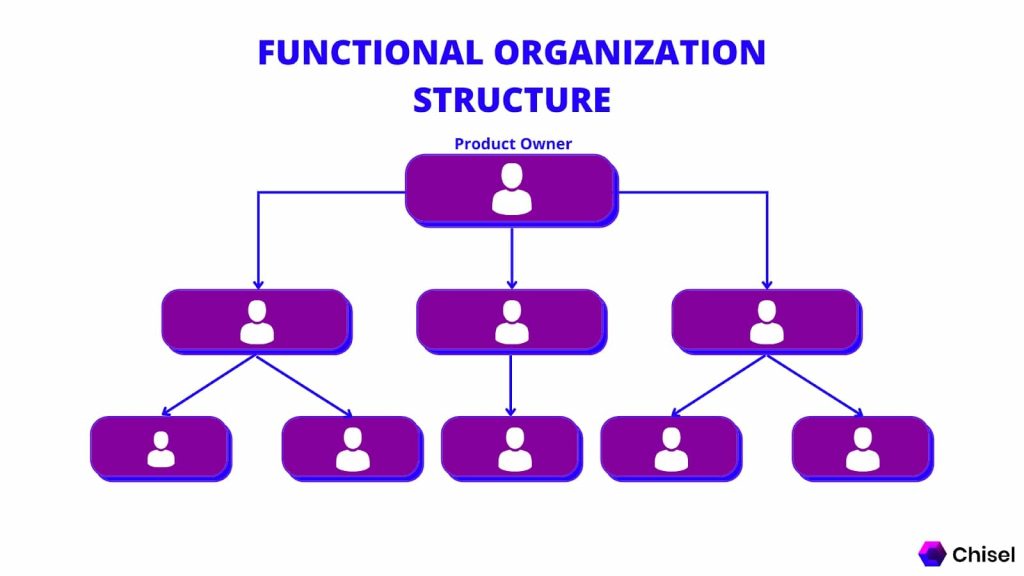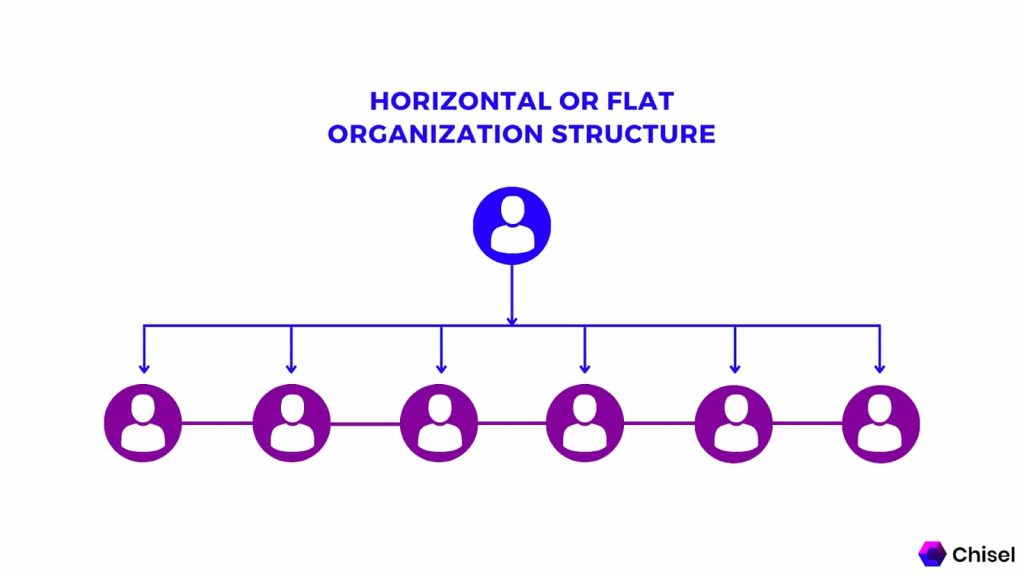How to Optimize Organizational Structure?

This article covers:
This article will discuss the best practices to hold a most efficient product team. You can improve team productivity from the knowledge of having to restructure organizations over time. When your organization is small, it is likely to work differently than when it starts growing.
We will provide a brief overview of things you should keep in mind when optimizing organizational structure. The goal is to help improve the efficiency and effectiveness of your organization, resulting in better team performance. Indeed, this has a direct impact on the product that you are building.
The first thing to do is aim for a flat organizational structure for your team. A flat organizational structure means having a lower hierarchy level between managers and employees who directly interact. Direct interaction leads to better communication because everyone works together rather than being split about what it means to have a “team.”
Managers and employees need to be able to work together so that the product can move forward. Such collective work in product management results in effective organizational functioning. It also results in better communication across roles.
Having clear metrics in place will help set goals and evaluate the success of initiatives. The metrics must reflect what is essential for the product to be successful.
Sometimes, it is necessary to change or remove specific roles in an organization if they are not working out as expected. A manager needs to have more control over his employees or vice versa.
It depends on what part of an organization should have ownership and who responds well under pressure from time management and other purviews. It is clear that to have a successful product, and the organizational structure needs to be in place.
Organizational structure is one of the most important aspects of any company. It defines people’s grouping process, what they do, and how they work together. However, as companies grow in size, they need to restructure their organizational structure to become more efficient for their functioning.
What Is Organizational Structure?
Definition
The organization’s coordination of individuals and teamwork is organizational structure. Individual effort must be coordinated and controlled to meet organizational goals and objectives.
An organizational structure defines how you manage particular tasks to fulfill an organization’s objectives. Rules, roles, and obligations are some of the activities.
The organizational structure also determines information flows between levels inside the corporation. For instance, in a centralized structure, decisions are made from the top down. But, in a decentralized structure, decision-making authority is divided across the organization’s tiers.
What Are the Types of Organizational Structure?
We learned what is organizational structure. Now let us look at the types of organizational structure. The organizational structure comprises seven categories.
Let’s go over them and understand why you want to use them.
Hierarchical organizational structure
A hierarchical organizational chart is a pyramid-shaped organizational structure. The most popular organizational structure is when the chain of command starts at the top and goes downwards.
Functional organizational structure
Like a hierarchical structure, the functional structure begins at the top with roles with the highest degree of authority and flows down. Employee arrangement depends on their skills and the company’s related purpose. Each unit runs independently.

Horizontal or flat organizational structure
The horizontal or flat organizational structure benefits organizations with minimal levels between higher administration and staff-level personnel. Many start-up enterprises adopt a horizontal organizational structure until they become significant enough to carve out various departments.
However, other organizations retain it since it fosters less monitoring and more engagement from all employees.

Divisional organizational structure
The divisional organizational structure provides a company’s sectors with authority over its resources. The functioning is almost independent within the broader organization. Every division will have its advertising, sales, and information systems departments. Big firms benefit from this structure because it allows different sections to make choices without answering a handful of managers.
Matrix organizational structure
A matrix organizational chart resembles a grid and depicts cross-functional teams formed for specific projects. For instance, an engineer could work in the engineering department (overseen by an engineering director) daily but on a temporary assignment (led by a project manager).
Both jobs and reporting come under the matrix organizational chart.
Team-based organizational structure
A team-based organizational structure that divides employees into teams, such as Scrum or tiger teams, should go without saying.
A team organizational structure aims at breaking up the conventional hierarchy. The design emphasizes problem-solving, collaboration, and providing employees more authority.
Network organizational structure
Few organizations nowadays have all services under one roof. The network organizational structure explains the distribution of resources. It can also refer to an internal organization that prioritizes open communication over hierarchy.
What Is the Importance of Organizational Structure?
- You can understand your company’s current aims and policies with a comprehensive understanding. You get a clear picture of authority and responsibility relationships.
- The channels and ways of interaction are set forth by the organizational structure. It makes running a successful business a lot easier.
- It supports the coordination of critical elements’ activities to enable the achievement of the organization’s objectives.
- It facilitates an organization’s expansion and diversity of activities.
- The involvement of employees in the organization fosters cooperation and motivation to work. It encourages initiative and original thought.
- Efficient and easy policy implementation. Also, quickly achieving goals.
- It eliminates function redundancy and allows the highest performance with the least effort.
What Is an Example of Organizational Structure?
Example 1: Many businesses organize themselves into finance, advertising, and staffing divisions. A manager then oversees each one of these departments. A supervisor or executive who manages many departments supervises this manager.
Example 2: A automobile company that divides its corporation into SUV, electric, and sedan vehicle divisions is an example of a divisional organization. While each branch serves a distinct purpose, they all strive to achieve the same goal: to make a sale.
What Organizational Structure Will Be Best for Your Organization?
Personal values, competitive drive, environment, and the mission and principles of your company are a few factors to consider. These aspects help you decide on the appropriate organizational structure suiting your organization.
Emerging businesses, which are less burdened by bureaucracy and tradition, have more flexibility.
For a valid reason, businesses that first made their way 50 or 150 years ago are more established in their practices. However, some people may benefit from gradually embracing advanced structures.
It comes down to regular tasks, brand identification, and workforce performance and productivity. A well-defined organizational structure is always necessary for business transformation, regardless of the type.
How To Optimize Organizational Structure?
It is vital to figure out the gaps. That is the gap between what has not worked in the past. Also, what is currently working and forecasting future needs.
One of the best ways to optimize an organizational structure is by considering the company’s culture, its products, and how it wants to work with customers.
Survey Your Team, Their Needs, and Expectations
You can also look at other companies and how they structure their teams. It’s essential to find what works best for your company and not blindly follow another organization’s lead.
Once you understand the action plan, it’s time to start restructuring the team. Restructuring is a daunting task as it will likely disrupt the previous boundaries with your team and peers. It’s also critical to have defined objectives for the new structure and how it will help the team be more effective.
It would be best to keep in mind that a restructured team is not permanent. You need to reassess it every few months to ensure that it still meets everyone’s needs.
Set up Tribe Leads
There are three Tribe leads, each representing a function:
- PM owning value/viability
- UX owning usability
- Engineering owning feasibility
The above implies that the PMs should ensure that the product delivers value to customers. Whereas UX designers should ensure that it’s usable by users and engineers are focused on building out a technical solution. It also means that you will have a product manager, designers, and engineers as part of that tribe. Learn more about product manager tools here.
Such a process allows for maximum communication between the team members. They do not need to go through multiple people before getting an answer from someone else in another department.
This approach also helps with knowledge sharing across departments, creating a more effective organization. It is of utmost importance that everyone understands the product.
The next step is to have an overall product owner who will own the vision for the product and work with the tribe leads to ensure distribution.
This role should not be confused with a project manager. Here the focus is more on delivering features than having a high-level understanding of the product and how to build it.
Team Has the Right Skill Set To Build the Product
Ensuring a proper skill set can be done by either hiring people with the required skill set or training existing employees.
Hiring people with the required skill set is more expensive. Still, it can result in a better product as it will ensure optimal functioning for the company’s growth.
Training existing employees is cheaper but can take more time as they need to learn the ropes of the new product.
Once you have hired the right people and organized them in the right way, it is essential to make sure that you can track their progress. You can track the progress by creating a roadmap for the product and investing in its progress.
The ultimate goal of this structure is to empower individuals at each functional layer with autonomy. But without losing sight of the end-user at every step. The ultimate goal here is team productivity.
You Should Center Your Users in This Process
Product teams should be structured to reflect the organization’s goals and how they want to work. If you’re looking to structure your product team, keep these three things in mind.
One, look out for the people who are passionate about the problem. Two, focus on empowering them to solve it in their way. Three, stay focused on your end-user at every step of this process.
People may start to feel disengaged. They’re unsure about their goal and whether they will own the problems they have until now.
The product team structure should align with how the company wants to work. As a product manager, it is your responsibility to make sure that this happens.
One way to empower your team and stay focused on your end-user is by using OKRs (Objectives and Key Results). OKRs will help keep everyone aligned on the project’s objectives.
Empower Your Team Is by Using Mini-projects
This approach will help them feel ownership of the product and give them a sense of accomplishment as they move through the project. The best way to stay focused on your end-user is by creating personas and user stories. It helps you understand their needs and how to make use of them.
No one has their strategy all worked out always.
Sometimes you will have to make changes on the go, and that’s okay. What’s important is that you’re constantly learning and improving your process.
It is alright to slip up from time to time. But, what matters is knowing what mistakes you made and discovering ways to avoid them in the future.
Empowering teams are suitable for all organizations, big or small. The key to success is adapting as your company grows and changes.
Avoid Cargo Culting
You should know why you are doing what you’re doing. You should also understand how it ties into the larger vision of your organization.
It is easy to get stuck in a rut when things become routine. However, you can avoid this if there’s someone within the organization constantly pushing for improvement.
Conclusion
There is no perfect way to organize a product team when it comes down to it. But understanding your company’s goals and tailoring them to their needs is part of the larger plan. It helps to reorganize and restructure as and when needed.
Hence, don’t take the labor to reorganize lightly. And it needs to be done to maximize your company’s potential.
It is also essential to ensure that the right people are in place to carry out these tasks. If you have a team that is too large, it will be necessary to split them up so they can work on different projects at one time.
If there’s no room for expansion within your organization or working with other teams becomes difficult because of organizational structure, this might signify the need for a restructure.
Many different signs will tell you it is time to reorganize your company, and these are just a few examples. However, the most important thing is to be proactive and not wait until things get too out of hand.
One of the best ways to stay efficient as a product team is to have a clear structure and stay organized. When your company starts to grow, it will be necessary to split them up so they can work on different projects at one time.
